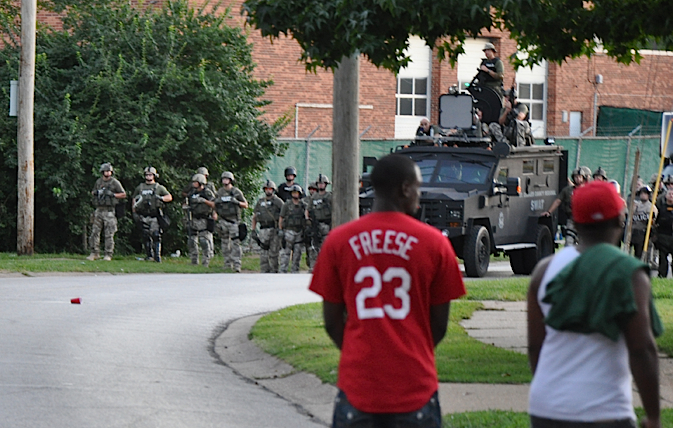The scenes that played out on the streets of Ferguson, MO this week are no aberration in American policing today. As a result of policies adopted in response to 9/11 and instigated by attitudes toward law enforcement originating in the “War on Terror,” it’s a small wonder we’re witnessing military-level police action on our streets only now. And despite the public outcry, it’s something we’re likely to see more of before we see less of it.
Prosecuting the War on Terror has reshaped domestic law enforcement fundamentally. In 2002, the 9/11 Commission called for increased collaboration between local police units and federal counterterrorism task forces. Known in security and academic circles as “integration of forces,” the approach incorporates military and counterintelligence strategies into routine policing, in many cases treating local protests and episodes of petty crime on par with coordinated terrorist activity and large-scale, often urban, acts of mass violence.
On their own, additional resources and cross-agency collaboration aren’t necessarily bad things. But police agencies have also been the recipients of military-grade equipment at steep discounts. Federal grants today make the acquisition of high-grade weaponry more accessible for city and local police forces than they ever have been before.
Even the budget crises plaguing many police departments after the 2008 financial crises haven’t in many cases stymied the purchase of armored vehicles, high-caliber weaponry, and crowd dispersing ammunition. Domestic law enforcement agencies have purchased over $4 million in surplus weapons from the Pentagon over the past fourteen years. In 2013 alone, the Defense Department transferred more than $449 million in supplies to local agencies.
A major culprit is the 1033 program, a federal initiative begun in 1997 that authorizes the Department of Defense to transfer equipment to municipal police forces for efforts at rooting out the drug trade. The “War on Drugs” marked the first modern, federally instigated push for cooperation between national law and local law enforcement agencies. Counterterrorism efforts in the wake of 9/11 often piggybacked on those structures and in many cases greatly expanded them.
Indeed, the 1033 program does not stipulate that materials earmarked for transfer be used solely in drug-related police action. And the military-grade tactical arsenals police departments increasingly found in their possessions has actually incentivized excessive shows of force. As the New York Times pointed out in a recent op-ed, the “militarizing of routine police work exacerbates tensions and increases the likelihood of disorder. This, in turn, appears to justify a militarized police response, and so the cycle continues.”
Driving that cycle is a way of thinking about policing that can’t be divorced from a post-9/11 security psychology. Like the War on Drugs whose programs it repurposed, the War on Terror was not conceived as a temporary, objective-based initiative. It required routine police work to sit side-by-side with combating domestic terrorism on a no less routine, continuous basis.
1033 mandates that all gear provided through the program must be used within one year of acquisition or be forfeited, so that resources police departments don’t use may be reallocated elsewhere. But the post-9/11 approach to policing made the reverse all but inevitable. Arsenals of armored vehicles, riot gear, and M-15 rifles went from seeming potentially extraneous to essential provisions. And the push to use them excessively became a default reflex.
A report by the ACLU observes, “Across the country, heavily armed Special Weapons and Tactics (SWAT) teams are forcing their way into people’s homes in the middle of the night, often deploying explosive devices such as flashbang grenades to temporarily blind and deafen residents, simply to serve a search warrant on the suspicion that someone may be in possession of a small amount of drugs. Neighborhoods are not war zones, and our police officers should not be treating us like wartime enemies.”
Until the ideological basis for that lack of discrimination is undone, more American neighborhoods will be subject to transformation into war zones. And as direct intervention in Iraq and Afghanistan de-escalates, federal defense agencies face mounting budgetary scrutiny, giving the push to sell off tools of war still greater urgency.
Bolstered by a federal mandate to assume stronger tactics, an emboldened resolve to pursue military tactics, and a hyper-inflated arsenal of tools to enact these newfound procedures, local law enforcement in the United States will continue to resemble domestic military operations. If the road to Ferguson was long and winding, so is the road out.
·
 Brian O’Connor is a Blog Editor for The Brooklyn Quarterly as well as a freelance writer and editor. By day, he is a book editor focusing on politics and current affairs.
Brian O’Connor is a Blog Editor for The Brooklyn Quarterly as well as a freelance writer and editor. By day, he is a book editor focusing on politics and current affairs.


One thought on “No Quiet on the Home Front”